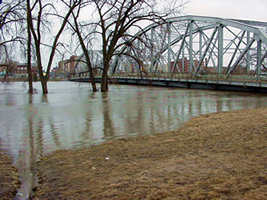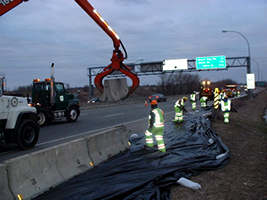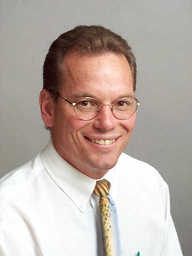 |
 |
 |
Flooding continues to command Mn/DOT's attention
|
 |
 |
 |
|
In a near replay of
the 1997 floods, the Red River of the North threatened to wash over the
Sorlie Bridge that connects East Grand Forks with Grand Forks, N.D.
Photo by Larry Randall
|
In a distressingly familiar way, Mn/DOT crews continue to deal
with the effects of major flooding by closing roads, building dikes and cleaning
up the mess left behind—just as they did during the disastrous floods of 1997.
Although generally not as severe as the 1997 floods, this year’s
flooding has caused heavy damage and disrupted the daily lives of many Minnesotans.
Coping with cold, wind, snow and varying forecasts of when
the state’s rivers would crest, Mn/DOT employees worked shoulder-to-shoulder
with volunteers, law enforcement officers, National Guard units and other agencies
to haul fill, build dikes, manage traffic and monitor water levels at bridge
sites.
While some crews in western Minnesota breathed sighs of relief
when the Minnesota River and the Red River of the North crested below 1997 levels,
other Mn/DOT workers are braced for later surges from the Minnesota, Mississippi
and St. Croix rivers in the state’s southeastern quadrant.
Floodwaters began to recede from water-covered roads in the
Detroit Lakes and Bemidji districts, leaving for maintenance crews the tasks
of repairing or replacing washed out shoulders and damaged roadways.
Herb Nelson, maintenance supervisor at Morris, said the damage
can vary widely from minimal where backwaters pooled on the roads to severe
where deep, fast-moving water caused heavy washouts.
Dan Peterson, a supervisor at Alexandria, said damage
is heavy on Hwy 75 at Wheaton.
“We have all the trucks in the district down here
to fix these shoulders,” he said.
“Much of the floodwaters have receded,” he added, “but water
and chunks of ice still cover Hwy 55 east of Wendell. We’re gaining on it, but
we couldn’t plow it off. We’ll have to push it off tomorrow with loaders.”
Part of Hwy 75 was reopened to traffic Tuesday, but other parts
of the highway and parts of several other highways in the district remain closed.
Dennis Marty, a maintenance supervisor at Willmar, said although
there were scares at places such as Montevideo, dikes and levees held the Minnesota
River and minimized damage there and in Granite Falls. Marty said officials
at Montevideo came close to closing Hwy 7 and Hwy 59 in the city but were able
to flag traffic through the water-covered roads in town without having to close
them. Parts of many other roads in the district, however, remain closed.
High water on the St. Croix forced closing of the Stillwater
Bridge. The bridge over the Mississippi between Wabasha and Nelson, Wis., was
closed for 24 hours when floodwaters covered the Wisconsin approaches to the
bridge.
Mankato’s bridge crew moved quickly among bridges at Henderson,
LeSueuer, St. Peter and New Ulm to determine how much damage the fast-moving
Minnesota River caused and to determine when bridges that are closed can be
reopened.
The swollen river forced the Mankato District to close both
Hwy 169 and Hwy 22 between St. Peter and Mankato, causing a major traffic disruption.
(Hwy 22 was scheduled to be reopened at 4 p.m. today.)
The district’s bridge and sign crews and its maintenance forces
have been working long hours since the floods began, but Woody Woodruff, a maintenance
supervisor at Mankato, said their morale is holding up even though they are
tired.
“We worked from 6 a.m. until 10:30 p.m. Saturday and Sunday,”
he said, ”but they’re a good crew and we’re still smiling.”
 |
|
Metro Division crews
build a dike made of concrete Jersey barriers and polypropylene sheeting
weighted with sand to protect the northbound lanes of I-35W in Burnsville
from flooding by the Minnesota River. Photo by Kevin Gutknecht
|
Metro Division crews worked through the night on Monday to
dike I-35W in Burnsville between Cliff and Black Dog roads to keep the Minnesota
River from flooding the vital freeway link. Crews from the Rochester District
built dikes that successfully kept the Mississippi River from flooding Hwy 61
at Lake City.
While the state’s road and bridges may have most people’s attention
during the floods, other modes of transportation are also affected.
The St. Paul Downtown Airport is closed and aircraft based
there, including Mn/DOT’s, moved to other locations. Federal Aviation Administration
staff at the airport has moved temporarily into the Office of Aeronautics building
in St. Paul. Mn/DOT is setting up a temporary control tower at the South St.
Paul airport. Amtrak has curtailed service between the Twin Cities and Chicago
because of track flooding and recreational boat use is restricted on the Mississippi
River.
In a news release issued April 17, Commissioner Elwyn Tinklenberg
saluted the work done by Mn/DOT employees combating the floods and urged the
public to support the department’s efforts to repair damaged roads and bridges.
“Our maintenance crews are working hard to assist communities
fighting the floodwaters around the state and they are ready to begin repairs
as those water level drop,” he said. “I want to thank motorists in advance for
their understanding about delays as we all pull together to minimize and repair
damage to the state’s highway system.”
To keep up on the changing flood situation, see Mn/DOT’s road and weather conditions
Web site, the TripUSA alerts
site or the Division of
Emergency Management site.
By Craig Wilkins
|
back

|
 |
Special time set aside to remember fallen workers
|
 |
 |
Tuesday, April 24, is Mn/DOT’s Worker’s Memorial Day. Along
with union workers of the AFL-CIO and the American Federation of State, County
and Municipal Employees, Mn/DOT will be remembering those individuals who have
been injured or killed while on the job. District 8 is hosting this year’s official
commemoration as part of its annual employee recognition days at Granite Falls.
Mn/DOT officials and union leaders ask everyone to participate
in a moment of silence at 2 p.m.
Since 1990, there have been more than 24,731 work zone accidents
in Minnesota, resulting in 119 fatalities and 11,405 injures to maintenance
and construction workers, motorists and pedestrians. Last year, 11 people died
in the state in roadway work zone-related accidents.
Worker Memorial Day is an opportunity to remind friends and
loved ones of the dangers of work zones.
By Mary Meinert
|
back

|
 |
Mn/DOT preserves historic plants on Lilac Way
|
 |
 |
Thanks to the preservation efforts of Mn/DOT and the City of
Brooklyn Center, 200 lilac bushes—originally planted in the 1930s along what
is now Highway 100 in Robbinsdale—will have a new home this spring three miles
north in Brooklyn Center.
The highway was named “Lilac Way” before it was upgraded and
designated as Highway 100 in the 1940s. After surviving more than 60 years of
traffic and urban development, the lilac plants looked like they were going
to fall victim to improvements planned for Highway 100 and 42nd Avenue in Robbinsdale.
Instead, generations to come can continue to enjoy
the gentle color and sweet fragrance of the lilacs, said Paul Walvatne, Mn/DOT
forester. The Office of Environmental Services, Metro Division maintenance and
Brooklyn Center parks staff cut the lilacs to the ground in preparation for
the move. Mn/DOT hired a contractor to move the lilacs to their new home. Transport
began April 16, with about 30 clumps scheduled to be moved each day. Brooklyn
Center is responsible for watering and weeding; Metro Division will mulch the
plants.
Another 150 clumps will be moved as part of the construction
contract in fall 2001. When the project is completed, a variety of new lilacs
will be planted to extend the blooming time from one week to three weeks on
the new, improved Lilac Way.
Existing shrubs are not usually preserved when new projects
are started, Walvatne said. In this case, however, the historical significance
and the economic advantage of having mature plants made preservation a reasonable
option. It also fits with Mn/DOT’s context-sensitive design approach where the
aesthetics and history impact project planning, he said.
Walvatne credits the vision of R.A. Nichols, consulting
landscape architect at the Minnesota Department of Highways in the 1930s, for
the first lilac way in the country. He wanted to create an attraction that would
draw visitors to Minneapolis, just as the cherry blossoms attract visitors to
Washington, D.C. each spring.
Walvatne described Nichols as ahead of his time. “Nichols would have fit right into the way
we work today, incorporating landscape design elements into projects, “ he said.
For more information, contact Paul Walvatne at 651/284-3793.
By Sue Stein
|
back

|
 |
Gray named chief financial officer
|
 |
 |
 |
Kevin Gray was recently
appointed Mn/DOT's Chief Financial Officer. Photo by Dave Gonzalez
|
Kevin Gray has been appointed Mn/DOT's chief financial officer.
Gray served in this position in an acting capacity since July 2000. He previously
served as director of business operations in the Metro Division since April
1998.
As Mn/DOT’s
CFO, he will oversee financial and accounting operations, fiscal analysis, accounting
systems, business development, and business planning and budgeting.
"Kevin has done an outstanding job as interim CFO, successfully preparing
Mn/DOT's budget and representing the department at the Legislature," said
Commissioner Elwyn Tinklenberg. "He has earned the CFO position. The department
will continue to benefit from his talents as he assumes the CFO position."
Gray, a certified public accountant, has worked in the private
sector for Arthur Andersen/Andersen Consulting as an auditor and director of
finance and administration for 15 years. He also worked two years for MCI Systemhouse
as the national director of human resources.
He received his bachelor’s degree in business administration,
with a major in accounting, from the University of North Dakota.
|
back

|
 |
Organizational changes to affect business planning, financial management areas
|
 |
 |
Several organizational changes affecting the business planning
and financial management areas will take effect May 1.
The Corporate Business Group will assume some of the responsibilities
of the former Office of Business Planning, including business planning, activity-based
budgeting, costing and management, and management analysis. These changes affect
the Management Analysis Section and the Activity Based Costing staff.
The performance planning part of the Office of Business
Planning (e.g., the measures and targets function) will reside in the Management
Operations Group. Staff for this area includes Dennis Feit, former Business
Planning director, and the Measurement and Evaluation Section.
Kevin Gray, director, Corporate Business Group, said the changes
will more clearly align business planning with the budget and resource allocation
processes and recognize the strong financial emphasis and resources required
to support activity-based costing and activity-based budgeting.
“This will help us clarify and move forward our business planning
and financial processes and systems to ensure that the department’s budget requests
are clearly linked to our strategic objectives,” Gray said. “It will also help
us achieve our goal of a revised budget approach—by product line and core activities—for
the 2004-2005 biennium.”
Linda Bjornberg, director, Management Operations Group, said
the performance planning unit will continue to provide assistance in identifying
measures of progress on strategic objectives and critical success factors. They
also will assist business units in identifying measures of on their actions
that support the agency performance reporting system progress (i.e., dashboards).
|
back

|
 |
Rochester names Arseneau as ADE for contract administration
|
 |
 |
 |
|
Bernie Arseneau recently
was named assistant district engineer for contract administration with
the Rochester District. Photo by Brian Jergenson
|
Bernie Arseneau, currently area maintenance engineer at Rochester,
was appointed as assistant district engineer for contract administration with
the Rochester District.
In his new position Arseneau will manage district construction,
materials, traffic and survey functions.
Arseneau’s previous experience includes work with
the State Aid to Local Government and Metro divisions and the offices of Traffic
Engineering and Intergovernmental Relations. He holds a bachelor’s degree in
civil engineering from the University of Minnesota.
His appointment becomes effective May 9.
The district also announced other changes in management
staffing. Tony Hames, ADE for program delivery, adds responsibility for planning,
design and right of way. Greg Paulson, ADE for state aid, gains responsibility
for bridges and structures and agreements.
Their new responsibilities also become effective
May 9. Telephone numbers for all three managers remain unchanged.
|
back

|
 |
Earley accepts state aid post with Detroit Lakes
|
 |
 |
Merle Earley was appointed as district state aid engineer with
the Detroit Lakes District. He succeeds Tallack Johnson who retired.
In his new position, Earley will manage the district’s
county state aid highway system, develop partnerships with government agencies
and provide leadership for delivery of other transportation products.
Before joining Mn/DOT, Earley served as the Stevens
County engineer. He also served as a project engineer for several projects in
Minnesota and the Dakotas and with a private engineering firm in Fargo.
Earley holds a bachelor’s degree in engineering from North
Dakota State University.
|
back

|
 |
Mn/DOT hires Native American affairs liaison
|
 |
 |
Linda Lyons has been appointed to the newly created position
of Native American Affairs Liaison for Mn/DOT.
According to Tim Worke, director, Government Relations, Lyons
will work with Mn/DOT district staff and state tribal governments to enhance
relationships and resolve issues on construction projects that affect tribal
lands, Native American sacred sites and tribal traditional cultural properties.
Lyons comes to Mn/DOT from the Mille Lacs Band
of Ojibwe where she most recently served as the commissioner of health and human
services. She has extensive experience working with many of Minnesota’s tribal
governments. Lyons has served as deputy director of the Leech Lake Band and
has also worked as the administrative officer for the Bureau of Indian Affairs.
Lyons holds a bachelor’s degree in accounting from Bemidji
State University and a master’s degree with a management concentration from
the University of St. Thomas in Minneapolis. She will assume her duties in late
May.
|
back

|
 |
Web offers new tools for B-BOP day
|
 |
 |
 |
|
Commuters who B-BOP
for the day will wear this B-BOP button. Bus drivers on Twin Cities Metro
Area lines will count riders who are B-BOPing, giving planners another
measure of participation.
The button is available in advance from employers who are participating
in the program. Mn/DOT employees can get their buttons by contacting Jarvis
Keys, Office of Transit, 651/297-3702.
|
Are you planning to B-BOP on May 17? If you participated
in the annual Bike, Bus or Pool Day in previous years, you may have used the
Web to get updates about the day’s events. This year the Web site moves from
simply providing information to being an interactive tool that will help measure
the effectiveness of the program and help planners prepare for future events.
Commuters who visit the B-BOP Web site can fill out online
pledge forms, promising to use an alternative form of transportation for the
day.
“This will give us a much better idea of how many people are
actually making the commitment to try B-BOPing,” notes Jarvis Keys, Office of
Transit. “In the past, our only way to tell how many people made a change for
the day was by counting how many hotdogs we went through at the noon-time event
at the Capitol!”
The pledge form will also ask participants several questions
about how they normally get to work—and what it would take to get them to consider
alternatives. This data will help planners learn about typical commuting patterns
and ways to encourage more people to try alternatives.
“Of course our goal is to change behavior for more than just
this one day,” Keys said. “We hope that if people try riding the bus, biking
or using one of the other alternatives to driving alone in their car, that they
will stick with it.”
With that in mind, the online pledge forms ask people to make
an ongoing commitment to B-BOP. “We’ll follow up with that and contact them
in the future to find out how they are doing,” Keys said.
Click here to learn more about B-BOP
day and to make your online pledge.
By Kay Korsgaard
|
back

|
 |
New on the Web: Site allows employees to
explore career options from home
|
 |
 |
 |
|
The Career Explorer
Web site is now available to employees from their home computers.
|
Where can you go to assess your career needs and plan your
future at Mn/DOT? How do you research existing employment opportunities within
Mn/DOT and the state of Minnesota? Where can you get help setting career and
development goals?
A good place to start is with Career Explorer, Mn/DOT’s online
career development program. In the past, you could only access Career Explorer
on Mn/DOT’s internal Web site from the office. Now Career Explorer is available
to employees from their home computers, too.
According to Rebecca Halabrin, Career Explorer project manager,
the online tool is geared to employees at all levels and stages of career
development and provides information about:
§
career assessment
§
employment opportunities within Mn/DOT and the State of Minnesota
§
setting career or development goals
§
action planning
§
available resources
Career Explorer includes
a number of exercises, work sheets and resources on topics such as developing
a resume and setting goals. Although the program is employee-directed, area
key contacts for the career explorer are available to provide additional assistance
on specific career development issues.
Career
development programs such as Career Explorer not only benefit employees but
also serve as an effective recruitment and retention tool for Mn/DOT, Halabrin
noted.
“The
site, which is linked to Mn/DOT’s competencies and performance management process,
is a resource for supervisors in their coaching and evaluation efforts,” Halabrin
said. “Research suggests that today’s employees greatly value career development
opportunities. Encouraging employee development
is an effective recognition tool.”
For more information about Mn/DOT’s Career Explorer, contact:
§
District 1—John Cavanaugh, Vickie Johnson
§
District 2—Kim VanVleet, Linda Vogt
§
District 3—Jerry Jones, Tina Warwick
§
District 4—Pam McLeod
§
District 6—Chris Frisbie
§
District 7—Sandra Lear
§
District 7B—Patricia Spencer
§
District 8—Nancy Carlson, Allan Rice
§
Metro—Norm Plasch, Linda Hinrichs, Nancy Pfeiler, Peggy Oberg, Barbara Laporte
§
Central Office—Ron Bisek, DeLorah Curry, Rebecca Halabrin
Web resources
§
Career Explorer (work)—available
on Mn/DOT’s internal Web site
§
Career Explorer (home)—available
from home computers
By
Donna Lindberg
|
back

|
 |
Question of the week
|
 |
 |
When the news media cover Mn/DOT projects heavily, it often
means that we, as individuals, get many questions from family, friends, neighbors
and strangers. When that happens, it helps to know Mn/DOT’s key messages so
that we all “speak with one voice.”
This week’s Question of the Week
comes from an employee asking exactly that question about a high-profile construction
project that’s received both legislative and media attention: the proposed reconstruction
of Highway 62 in the southwestern part of the Twin Cities metropolitan area.
For information about hot transportation issues,
go to Mn/DOT’s internal Web site. The Office of Communications and Public Relations
Web site also provides links to additional resources to help you communicate
about transportation issues.
|
back

|
|
 |
|


